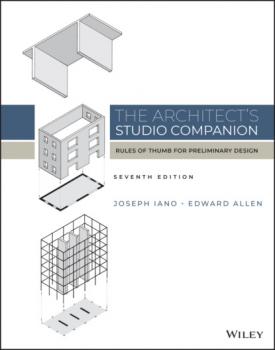ТОП просматриваемых книг сайта:















Edward Allen
Список книг автора Edward AllenАннотация
Here, in one volume, is all the architect needs to know to participate in the entire process of designing structures. Emphasizing bestselling author Edward Allen's graphical approach, the book enables you to quickly determine the desired form of a building or other structure and easily design it without the need for complex mathematics. This unique text teaches the whole process of structural design for architects, including selection of suitable materials, finding a suitable configuration, finding forces and size members, designing appropriate connections, and proposing a feasible method of erection. Chapters are centered on the design of a whole structure, from conception through construction planning.
Аннотация
The new industry standard on landscape architectural detailing Detailing for Landscape Architects takes the reader on an educational journey across three major areas of landscape architectural detailing—aesthetics, function, and constructibility—to demonstrate how powerful design patterns can transform thematic ideas into awe-inspiring built realities. Richly illustrated examples accompany concise discussions of a varied blend of landscape design/detailing issues such as water movement, soil environments, articulating structures and construction assemblies, life cycle costing, sustainability, health and safety, and more. This book approaches the subject of detailing in a systematic manner, and provides a balanced framework for design and workmanship that conveys the essence of the built landscape. Detailing for Landscape Architects shows how details can: Reinforce design ideas through the continuity and discontinuity of patterns Actively contribute to the overall form or geometry of the design Be designed to be durable and flexible while enhancing the entire design Gracefully accommodate the natural growth and change of plant materials Anticipate maintenance needs to minimize future disruptions Maximize their cost effectiveness through understanding their function while designing to meet those functions Including chapters that apply detail patterns to the design of an urban plaza, a roof deck, and a residence, Detailing for Landscape Architects offers guidance on solving specific technical requirements, while preserving and enhancing the visual qualities that celebrate innovation, and carry forth a timeless quality of building.
Аннотация
The leading guide to professional home construction, updated and expanded Fundamentals of Residential Construction is the definitive guide to single family and multifamily home building that details every step of the construction process. From siting and foundations to finishing details, this book provides a complete walk-through of professional home construction. Over 1,200 drawings and photographs animate the textbook, while interactive supplementary online resources help facilitate an understanding of the material. This fourth edition accommodates the latest developments in materials and methods, including new coverage of sustainable building and energy efficiency, multifamily construction, prefabricated building components, and CAD/BIM planning tools in residential construction. Authoritative coverage of wood light-frame construction, building systems, industrialized fabrication, insulating concrete forms, light-gauge steel and masonry construction, multi-family buildings, and more provides a solid foundation in residential construction methods, tools, and processes. Building a home requires a deeply integrated understanding of materials, structures, codes, and management procedures. Because the process involves such a broad array of considerations and challenges, construction professionals must regularly draw on a clear body of knowledge to keep a project running smoothly. This book helps you lay the groundwork of expertise required to successfully complete a residential project. • Learn the advantages and disadvantages of common materials and systems • Understand site preparation, foundations, and framing • Delve into the details of roofing, finishing, and energy efficiency • Understand heating/cooling, plumbing, and electrical options • Examine the latest codes, costs, and management best practices Designing and constructing a home presents a unique project dynamic; people's homes are their sanctuaries, where they make the memories of a lifetime. They must be designed to be lived in, not simply «used.» Lifetime costs play a major role in decision-making, materials must be carefully chosen and sourced, and spaces must be structured to be efficient yet enjoyable. Fundamentals of Residential Construction shows you how to bring it all together to turn a project into a family's cherished home.
Аннотация
The industry-standard guide to designing well-performing buildings Architectural Detailing systematically describes the principles by which good architectural details are designed. Principles are explained in brief, and backed by extensive illustrations that show you how to design details that will not leak water or air, will control the flow of heat and water vapor, will adjust to all kinds of movement, and will be easy to construct. This new third edition has been updated to conform to International Building Code 2012, and incorporates current knowledge about new material and construction technology. Sustainable design issues are integrated where relevant, and the discussion includes reviews of recent built works that extract underlying principles that can be the basis for new patterns or the alteration and addition to existing patterns. Regulatory topics are primarily focused on the US, but touch on other jurisdictions and geographic settings to give you a well-rounded perspective of the art and science of architectural detailing. In guiding a design from idea to reality, architects design a set of details that show how a structure will be put together. Good details are correct, complete, and provide accurate information to a wide variety of users. By demonstrating the use of detail patterns, this book teaches you how to design a building that will perform as well as you intend. Integrate appropriate detailing into your designs Learn the latest in materials, assemblies, and construction methods Incorporate sustainable design principles and current building codes Design buildings that perform well, age gracefully, and look great Architects understand that aesthetics are only a small fraction of good design, and that stability and functionality require a deep understanding of how things come together. Architectural Detailing helps you bring it all together with a well fleshed-out design that communicates accurately at all levels of the construction process.







